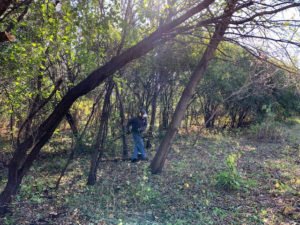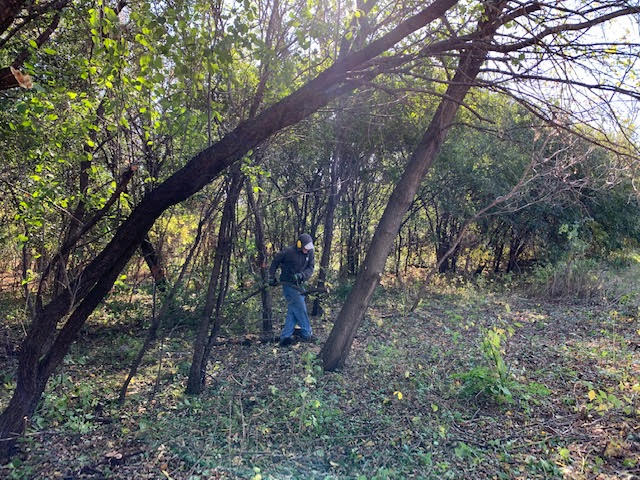by Dennis Dalman
First the four men donned protective gear for hands, eyes and ears, then they marched forward and began the battle – the battle against buckthorn in Sartell’s Lions Community Park.
Buckthorn is a formidable “enemy,” an invasive species that threatens healthy vegetation not just in Lions Park but just about everywhere in Minnesota and other places.
The four battlers included Sartell Lions President Stu Giffin and members Dennis Molitor, Al Moritz and Phil Ringstrom (Lions Park chairman). Giffin and Moritz were cutters, who sliced the buckthorn, leaving a stump. The “pullers and daubers” were Molitor and Ringstrom, who pulled away the debris and then daubed a systemic poison on the stump to kill the roots underneath.
Later, four Sartell Public Works employees picked up and discarded the piles of buckthorn.
By the end of two workdays, the Lions volunteers and city workers had removed about one-eighth of an acre of the buckthorn shrubs, which can grow into prickly trees up to 20 feet high. In fact, in Lions Park there are two buckthorn trees, each with a trunk about one foot in diameter, Ringstrom noted.
More work is required to remove even more buckthorn in that park, and more work is to take place in late October, early November. The ongoing partnership/cooperation between the Lions and the city has made such projects – and many others – possible through the years, Giffin said.
The noxious buckthorn once had a useful purpose. The plants were brought from Europe to serve as protective dense hedges and borders on crop land and pasture grazing lands. The trouble is, the once-useful plant became a real nuisance over time and caused dense thickets in forests, parks, roadsides and even in yards. Buckthorn, which grows via fibrous roots, crowds out native plants and takes over beneficial shrubs and small trees in forests where many species of birds nest, according to the Minnesota Department of Natural Resources.
Furthermore, the DNR states the prolific pest out-competes other good plants for light and moisture, contributes to erosion, forms impenetrable layers of vegetation, lacks natural controls (like insects, disease) and can harbor other pests such as crown-rust fungus and soybean aphids.
Buckthorn has glossy-green elongated leaves and toward fall purple-black berries. Birds often eat the berries and then excrete them here and there, causing the buckthorn to spread more and more.
The Lions Club members well know the battle against buckthorn in the park is not won. Come spring, they’ll have to gird up for battle and fight again.

Sartell Lions Club member Al Moritz cuts buckthorn in Lions Community Park in Sartell. Three other Lions Club members joined him in battling the invasive prickly shrub that can grow big as a tree.




